SEO
The 25 Biggest Traffic Losers in SaaS
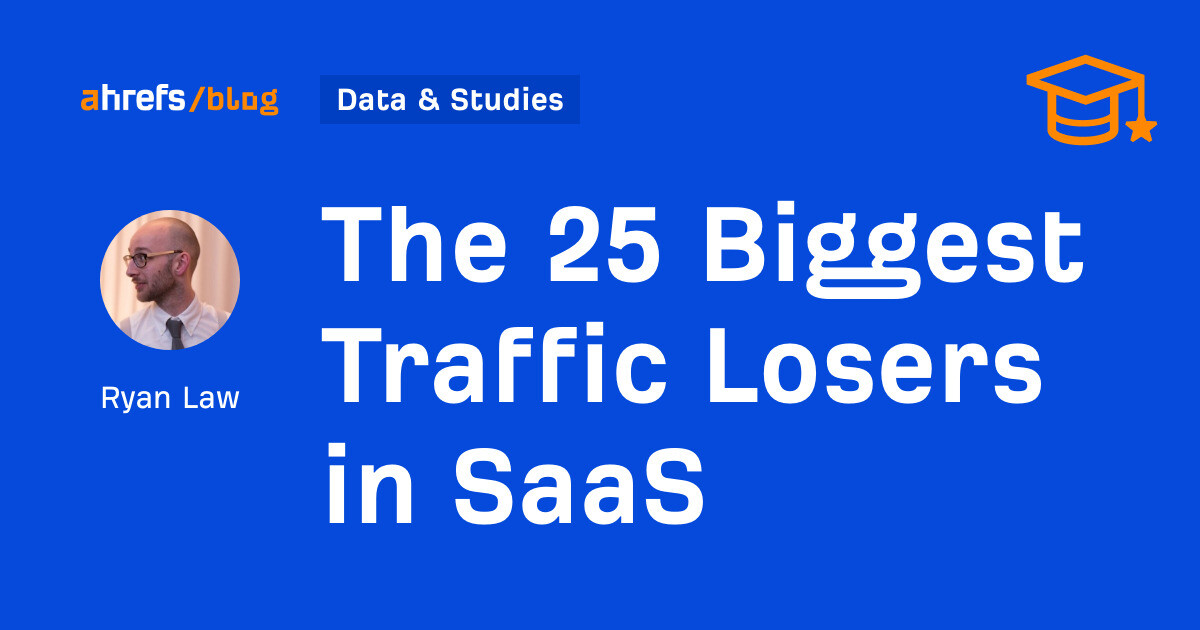
We analyzed the organic traffic growth of 1,600 SaaS companies to discover the SEO strategies that work best in 2024…
…and those that work the worst.
In this article, we’re looking at the companies that lost the greatest amount of estimated organic traffic, year over year.
- We analyzed 1,600 SaaS companies and used the Ahrefs API to pull estimated monthly organic traffic data for August 2023 and August 2024.
- Companies were ranked by estimated monthly organic traffic loss as a percentage of their starting traffic.
- We’ve filtered out traffic loss caused by website migrations and URL redirects and set a minimum starting traffic threshold of 10,000 monthly organic pageviews.
This is a list of the SaaS companies that had the greatest estimated monthly organic traffic loss from August 2023 to August 2024.
Sidenote.
Our organic traffic metrics are estimates, and not necessarily reflective of the company’s actual traffic (only they know that). Traffic loss is not always bad, and there are plenty of reasons why companies may choose to delete pages and sacrifice keyword rankings.
| Rank | Company | Change | Monthly Organic Traffic 2023 | Monthly Organic Traffic 2024 | Traffic Loss |
|---|---|---|---|---|---|
| 1 | Causal | -99.52% | 307,158 | 1,485 | -305,673 |
| 2 | Contently | -97.16% | 276,885 | 7,866 | -269,019 |
| 3 | Datanyze | -95.46% | 486,626 | 22,077 | -464,549 |
| 4 | BetterCloud | -94.14% | 42,468 | 2,489 | -39,979 |
| 5 | Ricotta Trivia | -91.46% | 193,713 | 16,551 | -177,162 |
| 6 | Colourbox | -85.43% | 67,883 | 9,888 | -57,995 |
| 7 | Tabnine | -84.32% | 160,328 | 25,142 | -135,186 |
| 8 | AppFollow | -83.72% | 35,329 | 5,753 | -29,576 |
| 9 | Serverless | -80.61% | 37,896 | 7,348 | -30,548 |
| 10 | UserGuiding | -80.50% | 115,067 | 22,435 | -92,632 |
| 11 | Hopin | -79.25% | 19,581 | 4,064 | -15,517 |
| 12 | Writer | -78.32% | 2,460,359 | 533,288 | -1,927,071 |
| 13 | NeverBounce by ZoomInfo | -77.91% | 552,780 | 122,082 | -430,698 |
| 14 | ZoomInfo | -76.11% | 5,192,624 | 1,240,481 | -3,952,143 |
| 15 | Sakari | -73.76% | 27,084 | 7,106 | -19,978 |
| 16 | Frase | -71.39% | 83,569 | 23,907 | -59,662 |
| 17 | LiveAgent | -70.03% | 322,613 | 96,700 | -225,913 |
| 18 | Scoro | -70.01% | 51,701 | 15,505 | -36,196 |
| 19 | accessiBe | -69.45% | 111,877 | 34,177 | -77,700 |
| 20 | Olist | -67.51% | 204,298 | 66,386 | -137,912 |
| 21 | Hevo Data | -66.96% | 235,427 | 77,781 | -157,646 |
| 22 | TextGears | -66.68% | 19,679 | 6,558 | -13,121 |
| 23 | Unbabel | -66.40% | 45,987 | 15,450 | -30,537 |
| 24 | Courier | -66.03% | 35,300 | 11,992 | -23,308 |
| 25 | G2 | -65.74% | 4,397,226 | 1,506,545 | -2,890,681 |
For each of the top five companies, I ran a five-minute analysis using Ahrefs Site Explorer to understand what may have caused their traffic decline.
Possible explanations include Google penalties, programmatic SEO, and AI content.
| Causal | 2023 | 2024 | Absolute change | Percent change |
|---|---|---|---|---|
| Organic traffic | 307,158 | 1,485 | -305,673 | -99.52% |
| Organic pages | 5,868 | 547 | -5,321 | -90.68% |
| Organic keywords | 222,777 | 4,023 | -218,754 | -98.19% |
| Keywords in top 3 | 8,969 | 26 | -8943 | -99.71% |
Causal is a finance platform for startups. They lost an estimated 99.52% of their organic traffic as a result of a Google manual penalty:
This story might sound familiar. Causal became internet-famous for an “SEO heist” that saw them clone a competitor’s sitemap and use generative AI to publish 1,800 low-quality articles like this:


Google caught wind and promptly issued a manual penalty. Causal lost hundreds of rankings and hundreds of thousands of pageviews, virtually overnight:


As the Ahrefs SEO Toolbar shows, the offending blog posts are now 301 redirected to the company’s (now much better, much more human-looking) blog homepage:


| Contently | 2023 | 2024 | Absolute change | Percent change |
|---|---|---|---|---|
| Organic traffic | 276,885 | 7,866 | -269,019 | -97.16% |
| Organic pages | 32,752 | 1,121 | -31,631 | -96.58% |
| Organic keywords | 94,706 | 12,000 | -82,706 | -87.33% |
| Keywords in top 3 | 1,874 | 68 | -1,806 | -96.37% |
Contently is a content marketing platform. They lost 97% of their estimated organic traffic by removing thousands of user-generated pages.
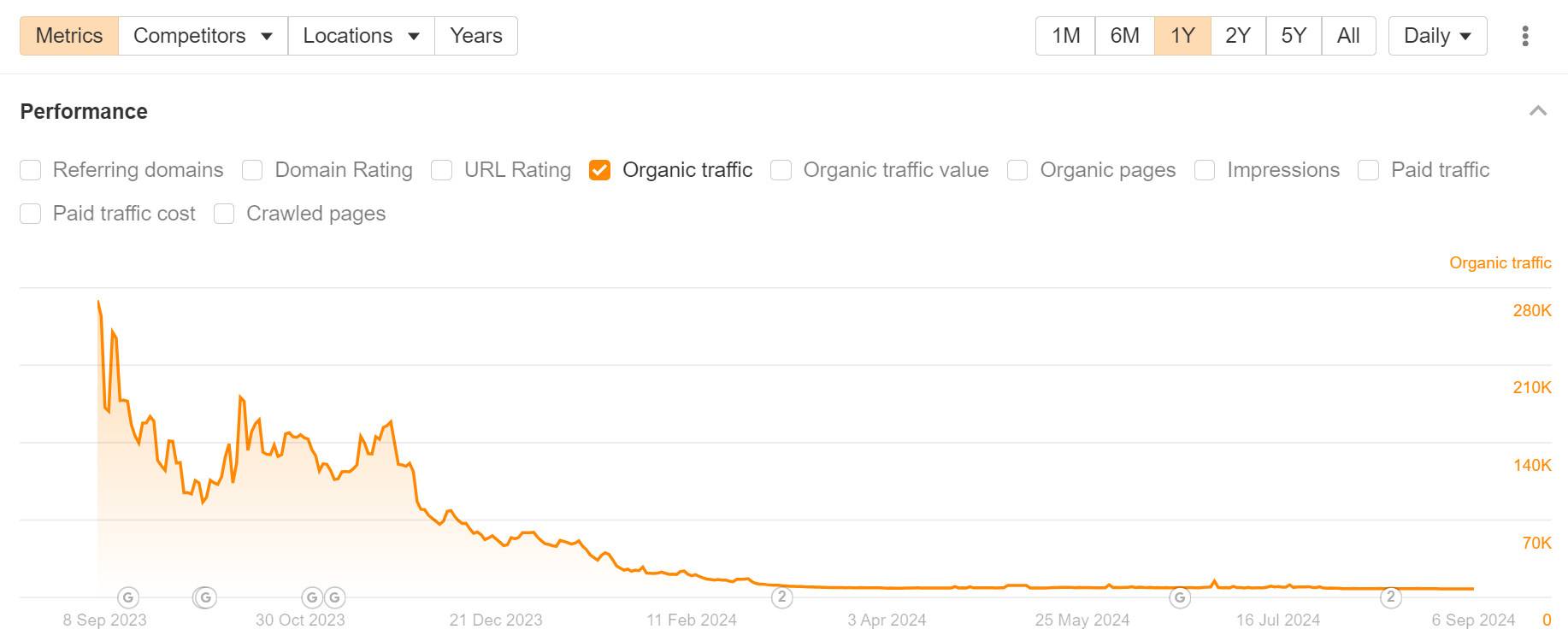

Almost all of the website’s traffic loss seems to stem from deindexing the subdomains used to host their members’ writing portfolios:


A quick Google search for “contently writer portfolios” suggests that the company made the deliberate decision to deindex all writer portfolios by default, and only relist them once they’ve been manually vetted and approved:
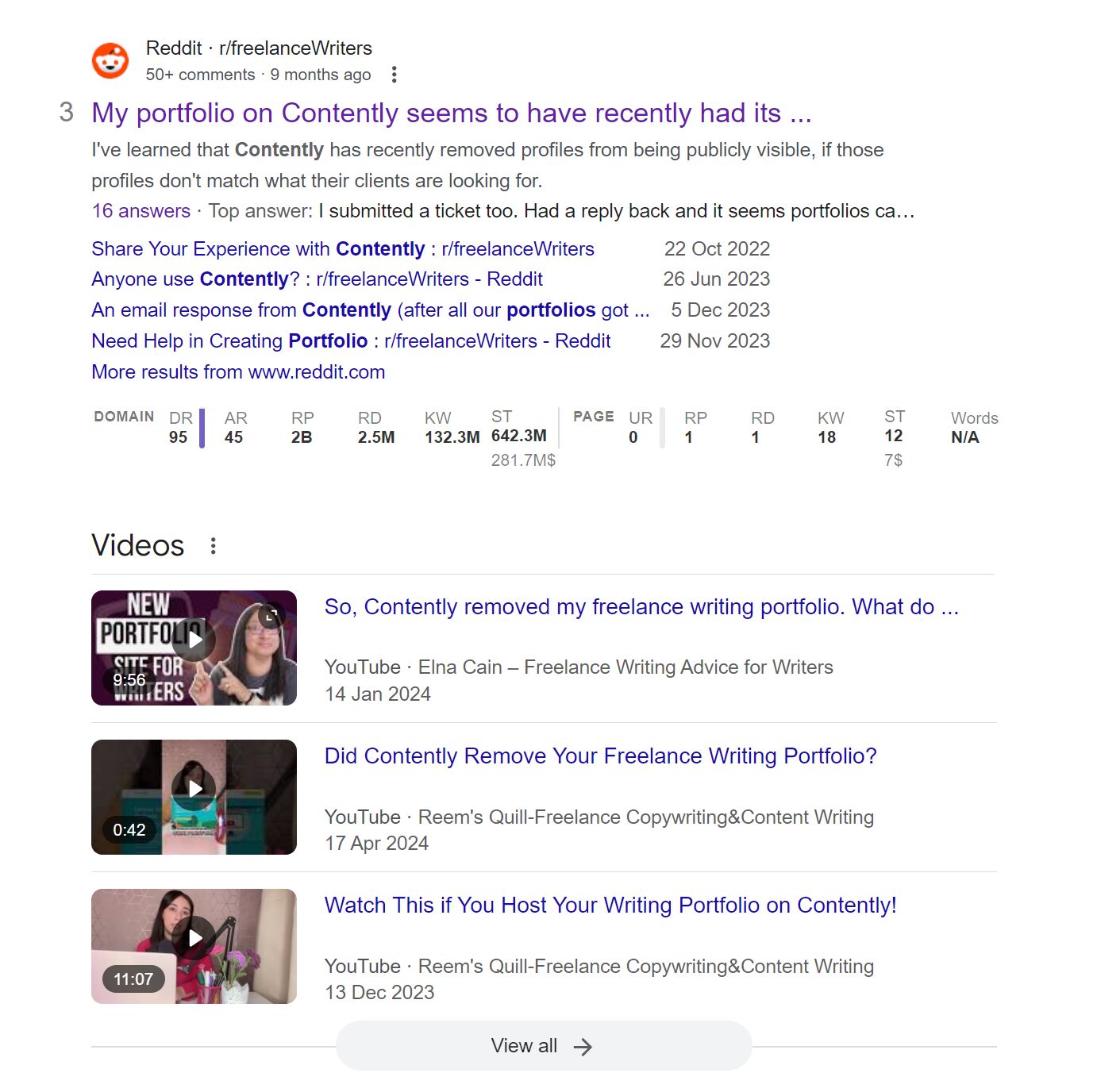

We can see that these portfolio subdomains are now 302 redirected back to Contently’s homepage:
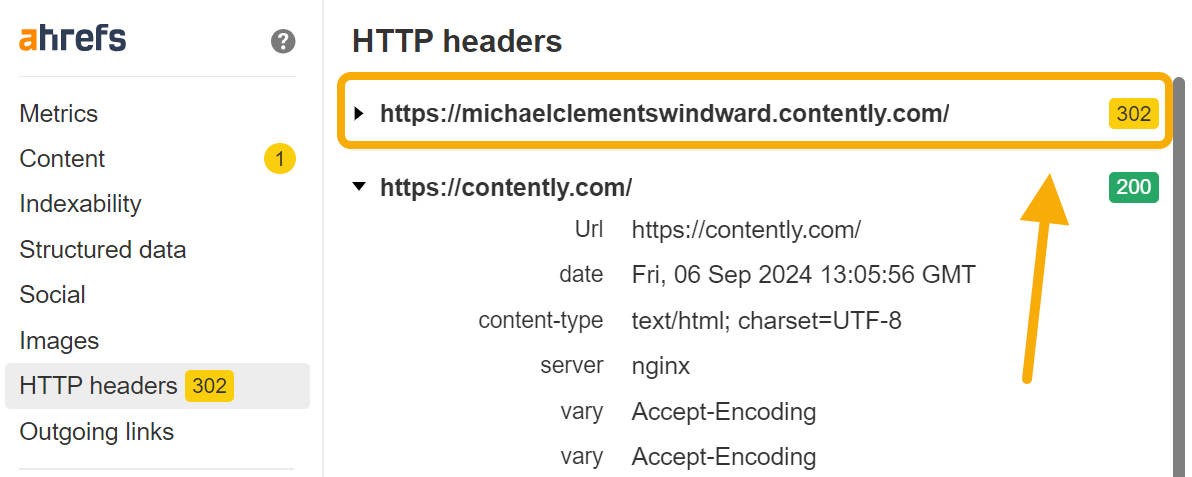

And looking at the keyword rankings Contently lost in the process, it’s easy to guess why this change was necessary. It looks like the free portfolio subdomains were being abused to promote CBD gummies and pirated movies:
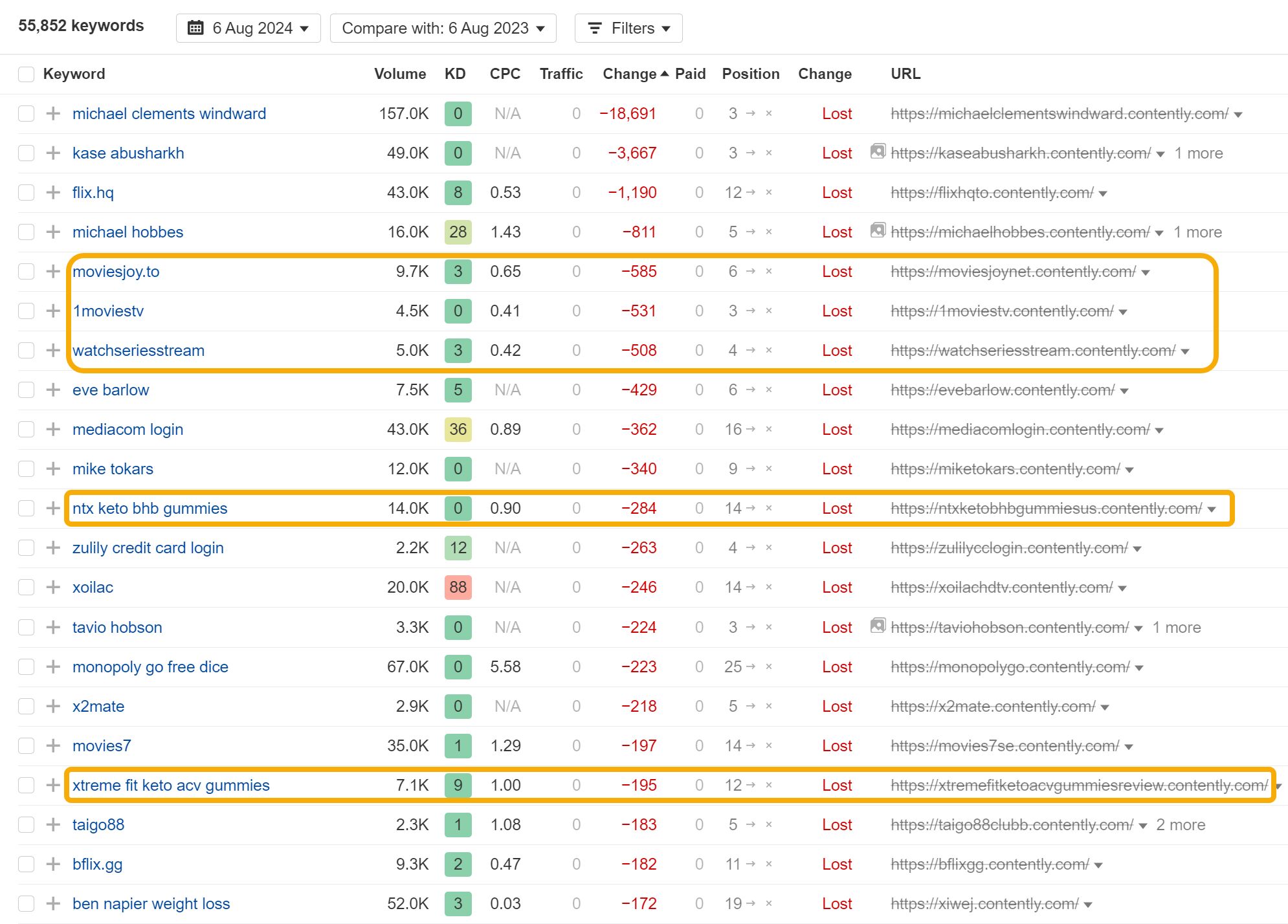

| Datanyze | 2023 | 2024 | Absolute change | Percent change |
|---|---|---|---|---|
| Organic traffic | 486,626 | 22,077 | -464,549 | -95.46% |
| Organic pages | 1,168,889 | 377,142 | -791,747 | -67.74% |
| Organic keywords | 2,565,527 | 712,270 | -1,853,257 | -72.24% |
| Keywords in top 3 | 7,475 | 177 | -7,298 | -97.63% |
Datanyze provides contact data for sales prospecting. They lost 96% of their estimated organic traffic, possibly as a result of programmatic content that Google has since deemed too low quality to rank.
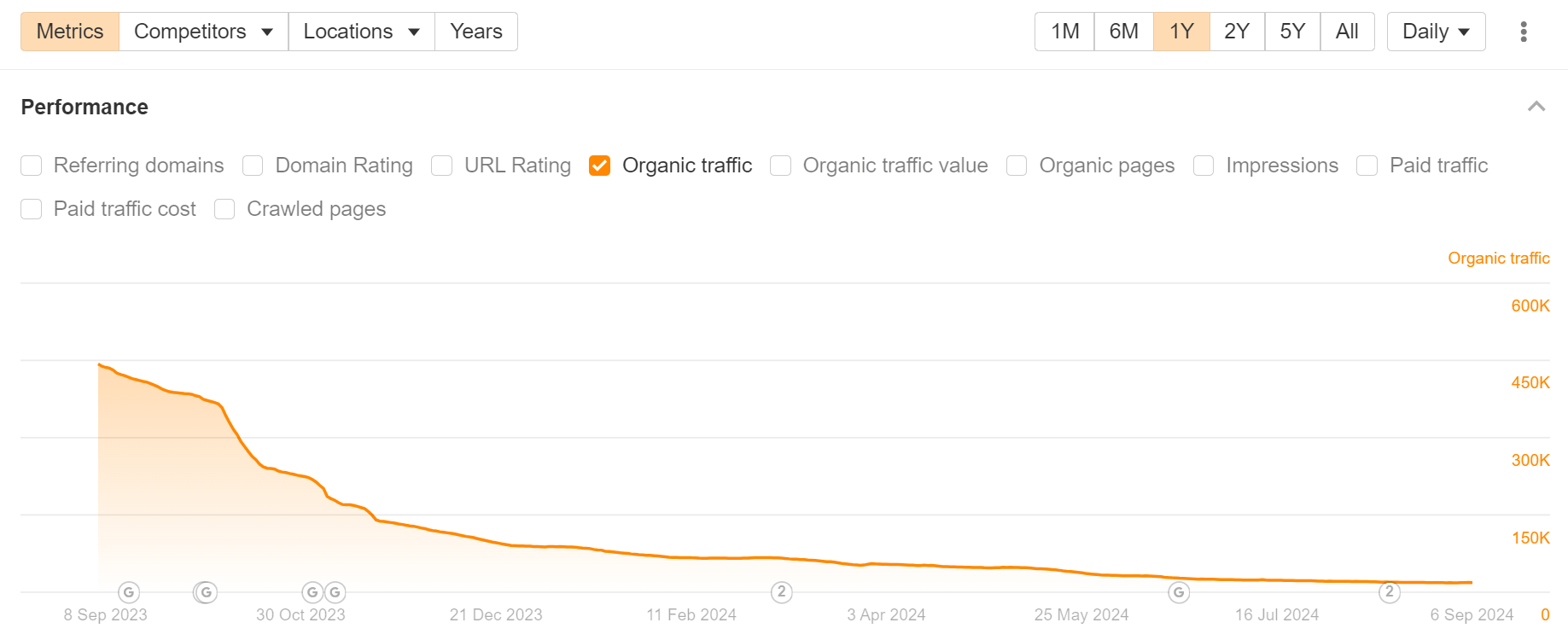

Looking at the Site Structure report in Ahrefs, we can see over 80% of the website’s organic traffic loss is isolated to the /companies and /people subfolders:


Looking at some of the pages in these subfolders, it looks like Datanyze built thousands of programmatic landing pages to help promote the people and companies the company offers data for:
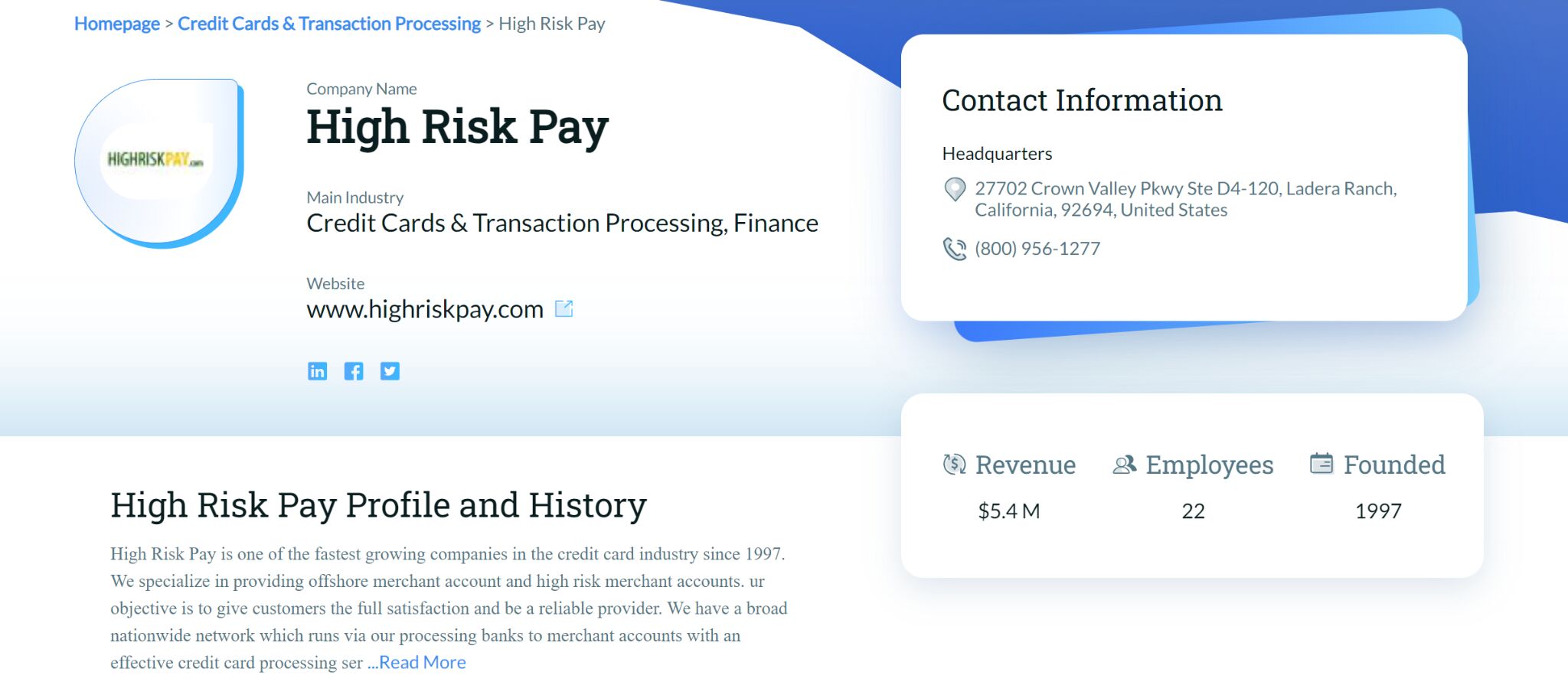

As a result, the majority of Datanyze’s dropped keyword rankings are names of people and companies:
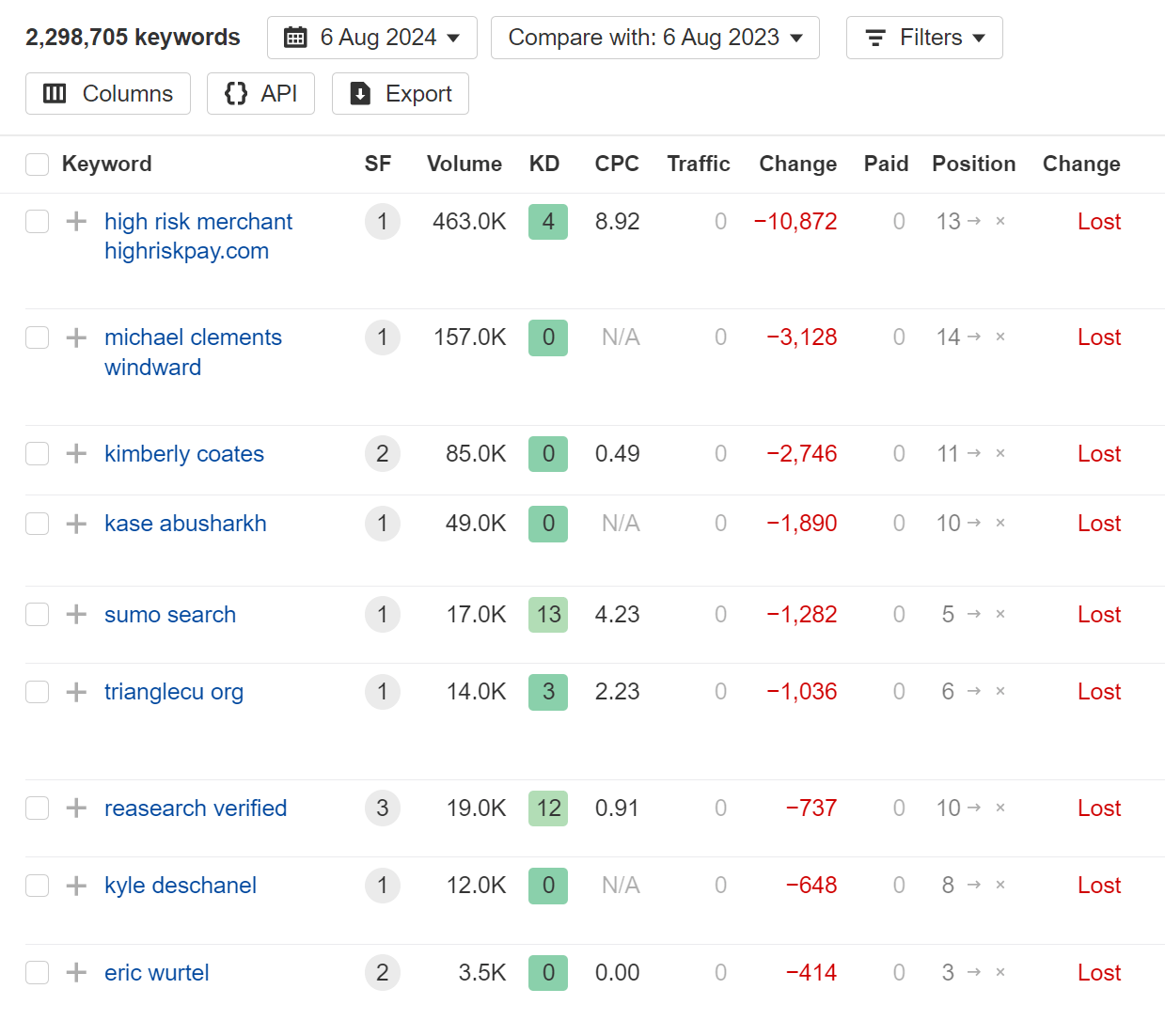

Many of these pages still return 200 HTTP status codes, and a Google site search still shows hundreds of indexed pages:


In this case, not all of the programmatic pages have been deleted—instead, it’s possible that Google has decided to rerank these pages into much lower positions and drop them from most SERPs.
| BetterCloud | 2023 | 2024 | Absolute change | Percent change |
|---|---|---|---|---|
| Organic traffic | 42,468 | 2,489 | -39,979 | -94.14% |
| Organic pages | 1,643 | 504 | -1,139 | -69.32% |
| Organic keywords | 107,817 | 5,806 | -102,011 | -94.61% |
| Keywords in top 3 | 1,550 | 32 | -1,518 | -97.94% |
Bettercloud is a SaaS spend management platform. They lost 94% of their estimated organic traffic around the time of Google’s November Core Update:
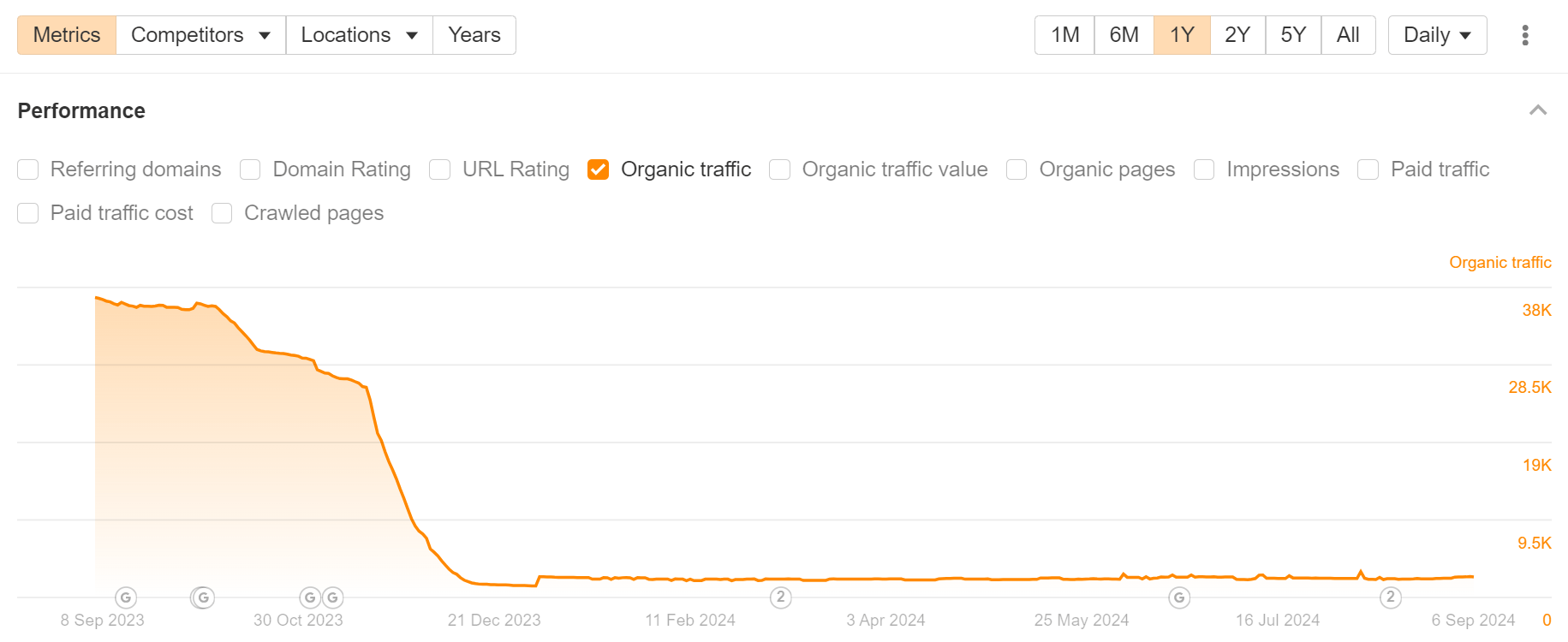

Looking at the Top Pages report for BetterCloud, most of the traffic loss can be traced back to a now-deleted /academy subfolder:


The pages in the subfolder are now deleted, but by using Ahrefs’ Page Inspect feature, it’s possible to look at a snapshot of some of the pages’ HTML content.
This short, extremely generic article on “How to Delete an Unwanted Page in Google Docs” looks a lot like basic AI-generated content:


This is the type of content that Google has been keen to demote from the SERPs.
Given the timing of the website’s traffic drop (a small decline after the October core update, and a precipitous decline after the November core update), it’s possible that Google demoted the site after an AI content generation experiment.
| Ricotta Trivia | 2023 | 2024 | Absolute change | Percent change |
|---|---|---|---|---|
| Organic traffic | 193,713 | 16,551 | -177,162 | -91.46% |
| Organic pages | 218 | 231 | 13 | 5.96% |
| Organic keywords | 83,988 | 37,640 | -46,348 | -55.18% |
| Keywords in top 3 | 3,124 | 275 | -2,849 | -91.20% |
Ricotta Trivia is a Slack add-on that offers icebreakers and team-building games. They lost an estimated 91% of their monthly organic traffic, possibly because of thin content and poor on-page experience on their blog.
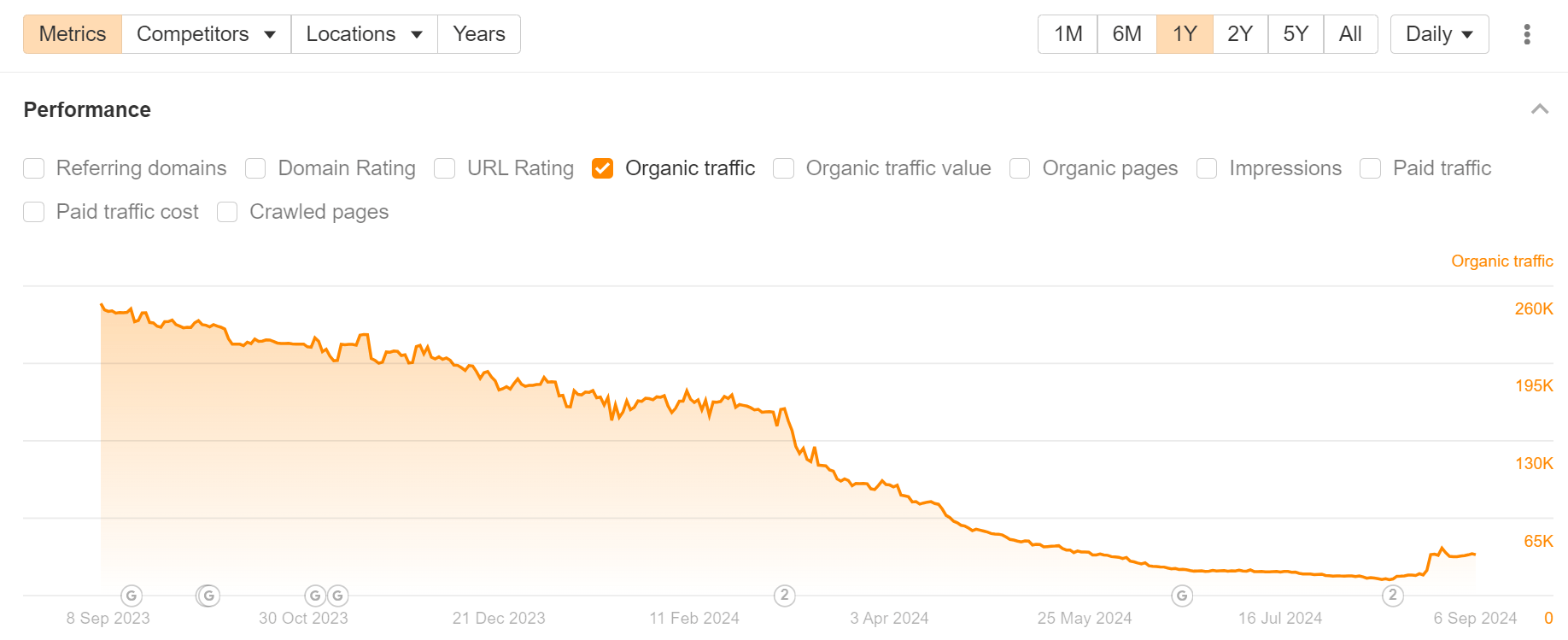

Looking at the Site Structure report, 99.7% of the company’s traffic loss is isolated to the /blog subfolder:


Digging into the Organic keywords report, we can see that the website has lost hundreds of first-page rankings for high-volume keywords like get to know you questions, funny team names, and question of the day:
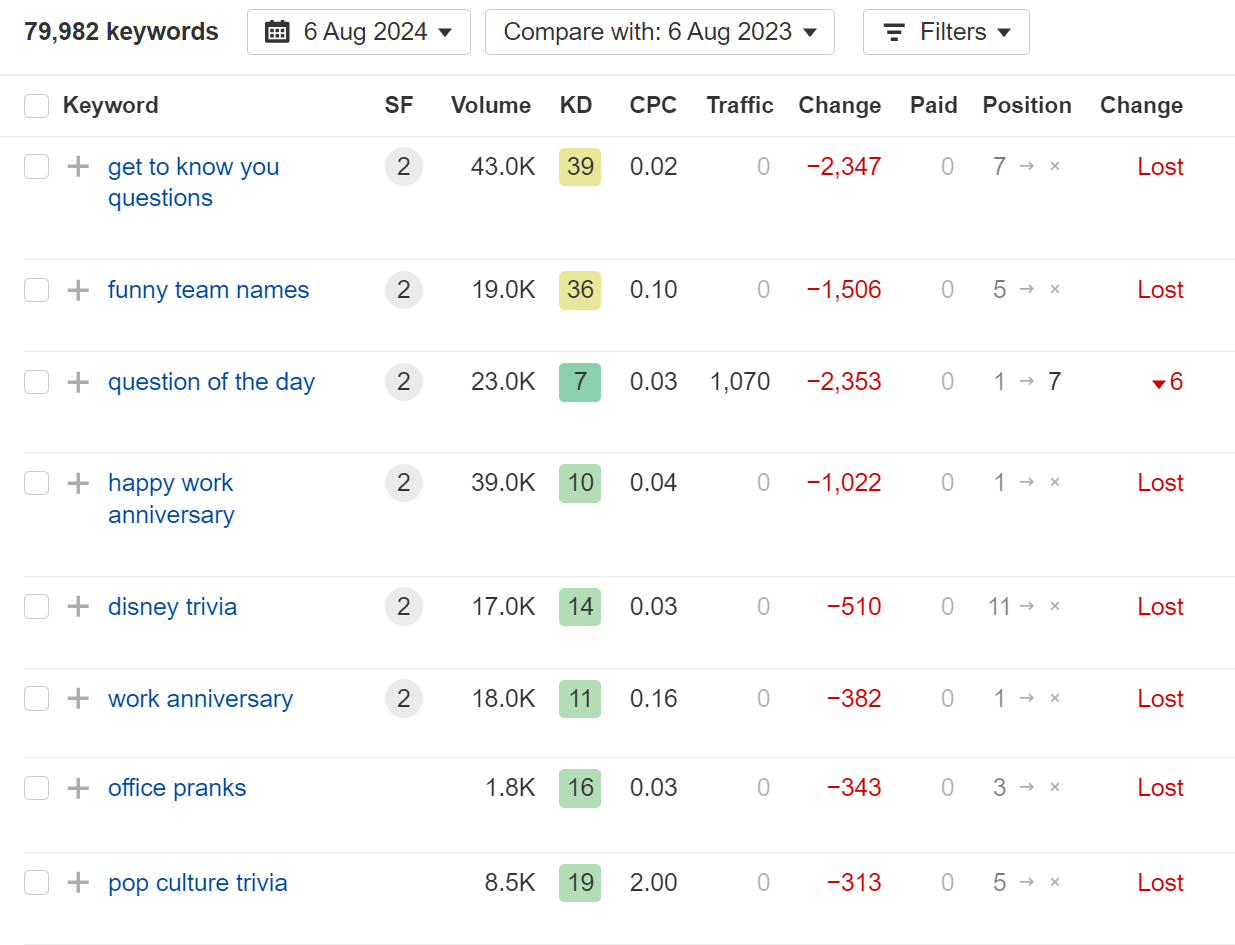

While these keywords seem strongly related to the company’s core business, the article content itself seems very thin—and the page is covered with intrusive advertising banners and pop-ups (a common hypothesis for why some sites were negatively impacted by recent Google updates):
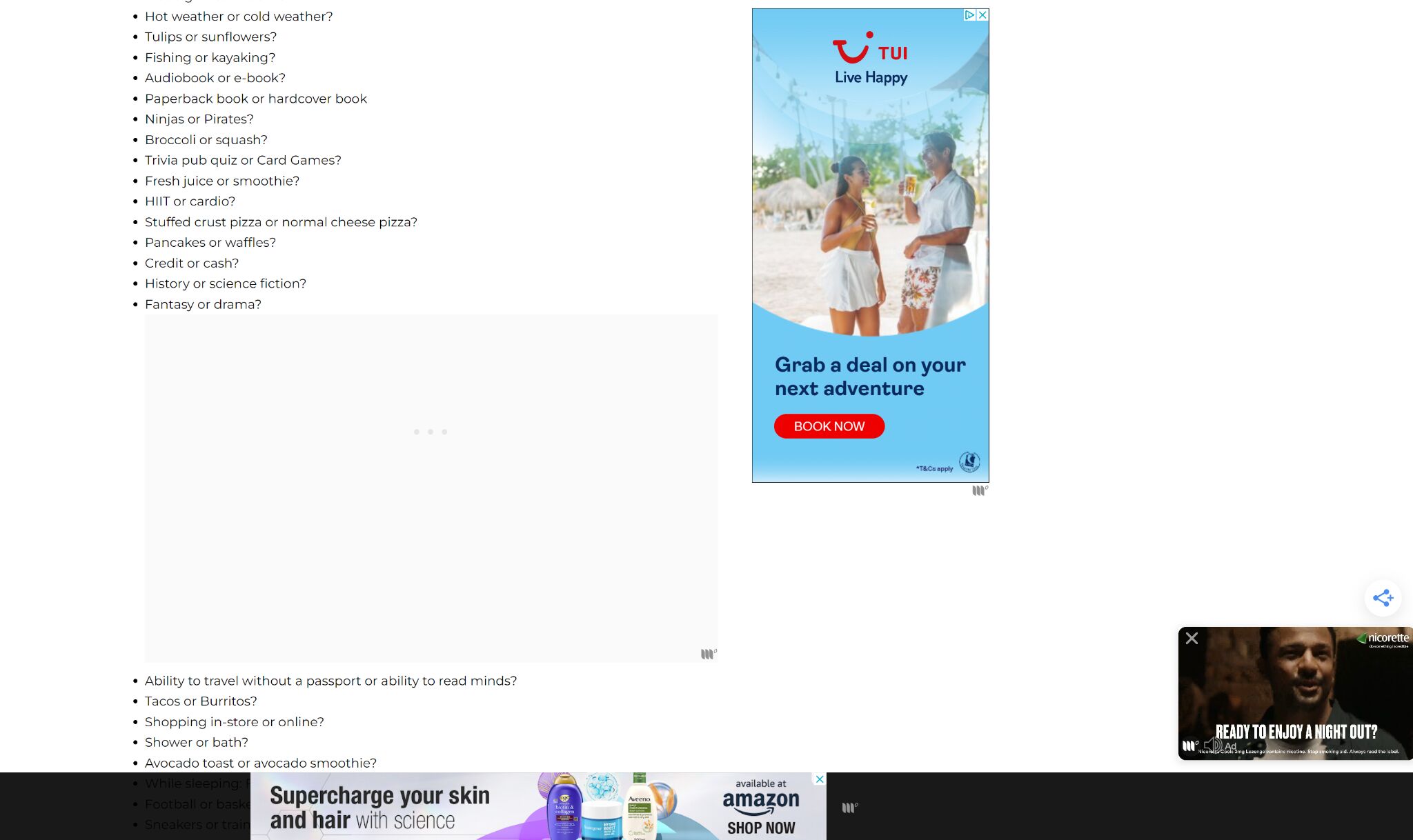

The site seems to show a small recovery on the back of the August 2024 core update—so there may be hope yet.
Final thoughts
All of the data for this article comes from Ahrefs. Want to research your competitors in the same way? Check out Site Explorer.

















